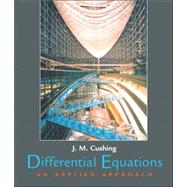
| Preface | xi | ||||
| Introduction | 1 | (18) | |||
|
1 | (8) | |||
|
9 | (10) | |||
| 1 First-Order Equations | 19 | (26) | |||
|
20 | (6) | |||
|
26 | (11) | |||
|
37 | (3) | |||
|
40 | (3) | |||
|
43 | (2) | |||
| 2 Linear First-Order Equations | |||||
|
45 | (10) | |||
|
55 | (5) | |||
|
60 | (5) | |||
|
65 | (4) | |||
|
69 | (3) | |||
|
72 | (1) | |||
| 3 Nonlinear First-Order Equations | 73 | (63) | |||
|
74 | (28) | |||
|
102 | (10) | |||
|
112 | (4) | |||
|
116 | (16) | |||
|
132 | (3) | |||
|
135 | (1) | |||
| 4 Systems and Higher-Order Equations | 136 | (40) | |||
|
138 | (4) | |||
|
142 | (11) | |||
|
153 | (13) | |||
|
166 | (6) | |||
|
172 | (3) | |||
|
175 | (1) | |||
| 5 Homogeneous Linear Systems and Higher-Order Equations | 176 | (50) | |||
|
176 | (4) | |||
|
180 | (12) | |||
|
192 | (4) | |||
|
196 | (17) | |||
|
213 | (5) | |||
|
218 | (6) | |||
|
224 | (1) | |||
|
225 | (1) | |||
| 6 Nonhomogeneous Linear Systems | 226 | (31) | |||
|
228 | (7) | |||
|
235 | (10) | |||
|
245 | (9) | |||
|
254 | (2) | |||
|
256 | (1) | |||
| 7 Approximations and Series Solutions | 257 | (28) | |||
|
257 | (11) | |||
|
268 | (8) | |||
|
276 | (7) | |||
|
283 | (1) | |||
|
284 | (1) | |||
| 8 Nonlinear Systems | 285 | (46) | |||
|
285 | (2) | |||
|
287 | (5) | |||
|
292 | (6) | |||
|
298 | (6) | |||
|
304 | (7) | |||
|
311 | (9) | |||
|
320 | (8) | |||
|
328 | (2) | |||
|
330 | (1) | |||
| 9 Laplace Transforms | 331 | (41) | |||
|
331 | (8) | |||
|
339 | (6) | |||
|
345 | (3) | |||
|
348 | (11) | |||
|
359 | (10) | |||
|
369 | (2) | |||
|
371 | (1) | |||
| Answers to Selected Exercises | 372 | ||||
| Index | I-1 |
The New copy of this book will include any supplemental materials advertised. Please check the title of the book to determine if it should include any access cards, study guides, lab manuals, CDs, etc.
The Used, Rental and eBook copies of this book are not guaranteed to include any supplemental materials. Typically, only the book itself is included. This is true even if the title states it includes any access cards, study guides, lab manuals, CDs, etc.